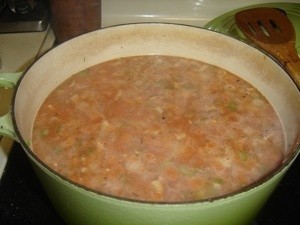 When making a batch of turkey stock the other day, I needed a large glass container to put it in to allow it to cool. The only one I could find was my old sun-tea jar - a very happy accident! It turned out to be the perfect stock-separator: large enough to hold all the stock from my 8 quart stock pot, and it's made of glass, so no yucky plastic-chemical-leaching.
When making a batch of turkey stock the other day, I needed a large glass container to put it in to allow it to cool. The only one I could find was my old sun-tea jar - a very happy accident! It turned out to be the perfect stock-separator: large enough to hold all the stock from my 8 quart stock pot, and it's made of glass, so no yucky plastic-chemical-leaching.
The dispensing spout sits about 1/2 inch from the bottom of the jar, which allowed the sediment to settle, and is not released when I turned the spout to "open" to fill my quart containers that go in the freezer. (I also rubber-band a paper coffee filter over the the spout to further filter out any fine impurities.) I just turned the spout to "off" when it got close to the fat layer. It used to take so long to scoop off the fat, strain the stock, etc., so I was very happy to discover this little trick, and I just had to share!
By Kimberly from Jax, FL
This page contains the following solutions.
I like to cook large batches of stews, chili, soup, etc. to eat, freeze, or give to friends. For this I use a large stock pot.
During my maternity leave we had only one income and I looked for ways to cut back on food bills. I kept cut-off tops/bottoms of carrots, asparagus, potato peels, cabbage cores, and any other veggie I used and placed them in the freezer.
With all the cold weather we have been having, a bowl of steaming soup brings us back to our mother's and grandmother's kitchens. Soup is a labor of love. Even if you don't like to cook, most of us can heat a can of soup and magically be brought back to that time and place.
Bouillon cubes are basically flavored squares of salt, whereas the paste bases are not as high in salt, and impart a much better flavor. You only use one or two tablespoons and the bases come in beef, chicken, mushroom, lobster, etc.
If you make your own consomme out of meat stock, boil egg shells in the finished stock for half an hour, and then strain. The shells clear the cloudiness wonderfully leaving you with beautiful, translucent liquid consomme.
When making homemade chicken broth, after it cools down, freeze it in an ice cube tray. Then when frozen, take the cubes and put in freezer bags.
I save all veggie peels, cooking water, cores, meat bones, etc., and always have a pot simmering on the woodstove. I am assured of having homemade soup stock on hand at all times. However, as much as we love it, my finicky teenaged daughter refuses to sample my soups du jour.
After heating up your left over broth, use a strainer and strain the broth. You now will be left with clean, clear broth just like it was freshly cooked.
Make a joint of meat (or a turkey or chicken) last a week by boiling the bones to make stock for soup. Just cover with cold water, bring to the boil and simmer for two hours.
Here are the questions asked by community members. Read on to see the answers provided by the ThriftyFun community.
I made homemade chicken noodle soup. After storing overnight in the refrigerator, I noticed the noodles had absorbed most of the broth. How do keep this from happening?
It's a really old post, from 2008. But I did a little internet research and it looks like there are a few possibilities on how commercially canned soup keeps the noodles from getting soggy.
One might be that they don't cook the noodles entirely, but add them into the mixture only partially cooked. That way, the noodles can slowly absorb the liquid after being canned.
People also suggest that egg noodles are generally used instead of pasta. Egg noodles don't absorb as much water.
Or they might just be really small noodles that don't feel so mushy when the canned soup is eaten.
Here is an interesting article I found online, which might also give you some information:
www.seriouseats.com/
Making soup from leftover scraps can be surprisingly good. Use up your leftovers, and freeze your vegetable scraps to make a low cost nutritious soup.
Shrimp shells have a surprisingly large amount of flavor when cooked down as a broth. Use the cooked broth to make all sorts of delicious soups.
Rather than buying chicken stock, you can easily make it at home. It's much healthier than using buillion or packaged broth for your soups and stews.
ThriftyFun is one of the longest running frugal living communities on the Internet. These are archives of older discussions.
My mom taught me how to save quite a lot by adding leftovers to a zip lock freezer bag until it was full and then later thawing it out in the soup pot.
I take all the leftovers that there aren't enough of for another dinner and put them in the bucket.